C1.4 Create and describe patterns to illustrate relationships among whole numbers up to 100.
Skill: Creating and Representing Number Patterns Involving Whole Numbers up to 100
The base ten system includes multiple patterns that help deepen understanding of number relationships.
Source: translated from Curriculum de l'Ontario, Programme de mathématiques de la 1re à la 8e année, 2020, Ministère de l'Éducation de l'Ontario.
Students demonstrate their understanding of the concept of patterns by creating and explaining number patterns, such as decompositions of numbers or sets of related operations. This is an opportunity for students to make connections between positional values, as well as between addition and subtraction, and to understand the inverse relationship between these two related operations.
Teachers can offer students a whole number less than 100, such as 86, and ask them to decompose that number by position value to determine the pattern rule.
Example
86=
8 tens
+ 6 ones
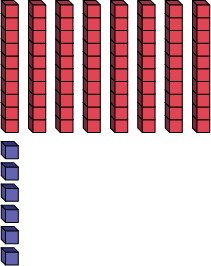
86=
7 tens
+ 16 ones
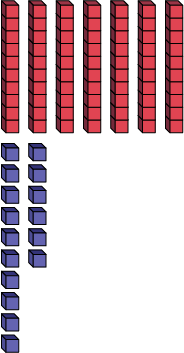
86=
6 tens
+ 26 ones
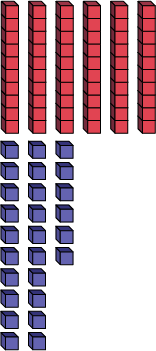
86=
5 tens
+ 36 ones
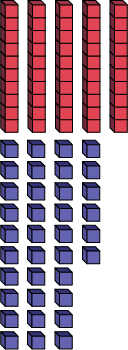
86=
4 tens
+ 46 ones
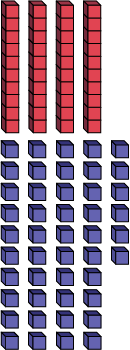
86=
3 tens
+ 56 ones
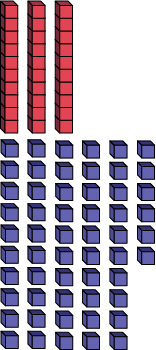
86=
2 tens
+ 66 ones

86=
1 ten
+ 76 ones
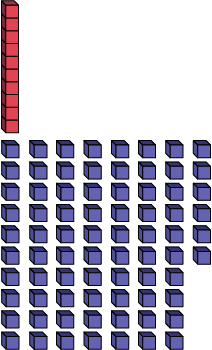
86=
0 tens
+ 86 ones

This allows students to establish the relationship between positional values (tens and units), that is, that a ten is equal to 10 units.
Have students create a pattern of operations using concrete or visual (semi-concrete) materials (for example, number grid, number lines, ten frame, interlocking cubes, base ten materials) using larger numbers. Students then exchange their set of operations with another person, build the related set with the associated subtraction facts, and finally can use this knowledge when performing calculations with larger numbers.
In this way, students notice that addition and subtraction also have an inverse relationship when the numbers are larger.
Example
64
| + | - |
|---|---|
| 60 + 4=64 | 64 - 4=60 |
| 61 + 3=64 | 64 - 3=61 |
| 62 + 2=64 | 64 - 2=62 |
| 63 + 1=64 | 64 - 1=63 |
| 64 + 0=64 | 64 - 0=64 |
Have students use their knowledge of number facts to 10 in their calculations involving larger numbers.
Example
In this way, students notice that knowledge of number facts to 10 can help them perform calculations with larger numbers.
Skill: Describing Number Patterns of Whole Numbers up to 100
By observing and analyzing the relationships between numbers within a pattern, within a number sentence, or within the base ten system, students discover patterns and can deepen their understanding of algebraic concepts.
Source: translated from Guide d’enseignement efficace des mathématiques de la maternelle à la 3e année, Modélisation et algèbre, Fascicule 1, Régularités et relations, p. 16.
To get students to verbalize their observations, identify relationships, and explain how the use of patterning helped them in seeing the relationship between numbers, it is important to ask relevant questions such as:
- What do you notice?
- What is repeated?
- What do you add? What are you taking away?
- What does this number represent?
- How could you represent this number differently?
- What is the link between your two representations?
- How have the number facts you know helped you calculate larger numbers?
- How do you know that addition and subtraction are inverse operations? In what situation might this help you?
To help students establish an intuitive understanding of the structure of the pattern, teachers encourage them to verbalize their observations.
In the example of the number 86, students can describe the pattern of operations by explaining that the ten decreases by 1 and the units increase by 10, until there are 0 tens and 86 units.
In the example of the number 604, students can describe the inverse relationship of addition and subtraction by noticing, for example, that the numbers in the related operation are the same, but the order changes. Students can also describe their observations for addition that the sum always equals 604. As the first number increases by 1, the second number decreases by 1. Students can also describe their observations for subtraction by explaining that the difference increases by 1, the first number is always equal to 604, and the second number decreases by 1.
Using the example of the multiplication number facts and the associated division facts from the previous section, students can describe the pattern they noticed for the multiplication by noting that the product increases by 7, the first number remains constant, while the second number increases by 1. Students can describe the pattern they noticed for division by explaining that the first number increases by +7, the second number increases by 1, and the quotient remains constant at 7. The numbers are the same in the multiplication and associated division statements, but the order changes.
